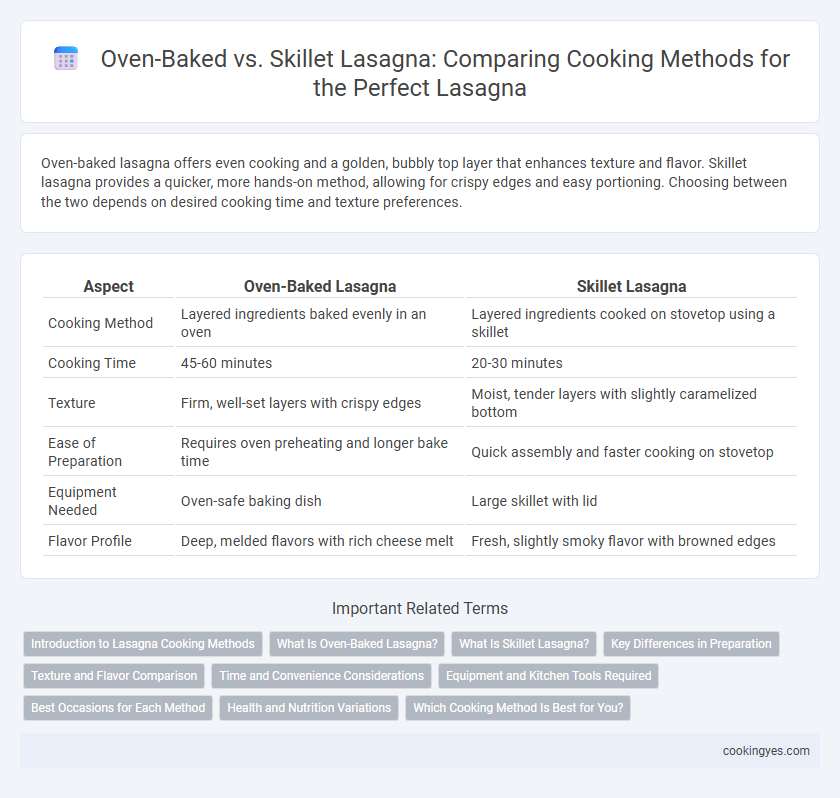Oven-baked lasagna offers even cooking and a golden, bubbly top layer that enhances texture and flavor. Skillet lasagna provides a quicker, more hands-on method, allowing for crispy edges and easy portioning. Choosing between the two depends on desired cooking time and texture preferences.
Table of Comparison
| Aspect | Oven-Baked Lasagna | Skillet Lasagna |
|---|---|---|
| Cooking Method | Layered ingredients baked evenly in an oven | Layered ingredients cooked on stovetop using a skillet |
| Cooking Time | 45-60 minutes | 20-30 minutes |
| Texture | Firm, well-set layers with crispy edges | Moist, tender layers with slightly caramelized bottom |
| Ease of Preparation | Requires oven preheating and longer bake time | Quick assembly and faster cooking on stovetop |
| Equipment Needed | Oven-safe baking dish | Large skillet with lid |
| Flavor Profile | Deep, melded flavors with rich cheese melt | Fresh, slightly smoky flavor with browned edges |
Introduction to Lasagna Cooking Methods
Oven-baked lasagna offers even heat distribution, allowing layers of pasta, cheese, meat, and sauce to meld perfectly while achieving a golden, bubbly top crust. Skillet lasagna provides a quicker cooking method with high heat, creating a crispy bottom layer and tender interior in a single pan. Both methods highlight different textures and flavors, catering to diverse preferences in traditional Italian cuisine.
What Is Oven-Baked Lasagna?
Oven-baked lasagna involves layering pasta sheets, ricotta cheese, marinara sauce, and ground meat or vegetables in a deep dish, then baking it at around 375degF (190degC) for 45-60 minutes to achieve a bubbly, golden-brown crust. This method allows the flavors to meld together and the cheese to melt evenly, creating a rich, tender texture throughout. The slow, consistent heat of an oven provides thorough cooking, ensuring the pasta absorbs the sauce while the top crisps to perfection.
What Is Skillet Lasagna?
Skillet lasagna is a quick-cooking variation of traditional lasagna prepared entirely in a single skillet on the stovetop, combining layers of pasta, sauce, cheese, and meat without the need for oven baking. This method uses pre-cooked or no-boil noodles and allows for faster cooking times while maintaining rich flavors and a creamy texture. Skillet lasagna is ideal for easy cleanup and convenient, one-pot meals, especially when time or oven access is limited.
Key Differences in Preparation
Oven-baked lasagna involves layering pasta, sauce, cheese, and fillings in a baking dish and cooking it evenly at a consistent temperature, allowing flavors to meld and the top to brown. Skillet lasagna is prepared by cooking ingredients directly in a stovetop pan, often with fewer layers and a faster cooking time, resulting in a different texture and more pronounced caramelization. The key difference lies in oven baking's gradual heat distribution versus the skillet's direct heat contact, influencing moisture retention and crust formation.
Texture and Flavor Comparison
Oven-baked lasagna develops a rich, bubbly crust with evenly melted cheese and tender pasta layers, enhancing a harmonious blend of flavors. Skillet lasagna offers a crispy bottom layer with slightly firmer noodles, providing a contrast in texture and a more pronounced caramelized taste. The choice between methods depends on whether a soft, slow-cooked consistency or a crispy, quick-cooked edge is preferred.
Time and Convenience Considerations
Oven-baked lasagna typically requires 45-60 minutes, offering even heat distribution for uniform cooking and a golden, crispy top layer. Skillet lasagna cooks faster, often within 20-30 minutes, providing greater convenience by combining stovetop cooking and minimal cleanup. Time-conscious home cooks benefit from skillet lasagna's speed, while traditionalists prefer the texture and depth achieved with oven-baking.
Equipment and Kitchen Tools Required
Oven-baked lasagna requires a baking dish, typically glass or ceramic, and an oven preheated to around 375degF (190degC) for even cooking and browning. Skillet lasagna demands a large, oven-safe skillet or cast-iron pan to allow both stovetop simmering and oven finishing, minimizing the need for multiple dishes. Essential kitchen tools include a spatula for layering and serving, and a thermometer to ensure the internal temperature reaches 165degF (74degC) for food safety.
Best Occasions for Each Method
Oven-baked lasagna is ideal for family gatherings and dinner parties, offering a classic, evenly cooked dish with a golden, bubbly cheese topping. Skillet lasagna suits quick weeknight meals or intimate dinners, providing a faster cooking time and crispier edges. Each method enhances texture and flavor tailored to the occasion's timing and formality.
Health and Nutrition Variations
Oven-baked lasagna typically allows excess fats to drain during cooking, resulting in a slightly lower fat content compared to skillet lasagna, which often retains more oils and cheeses due to stovetop preparation. Skillet lasagna can preserve more moisture and nutrients in vegetables by shorter cooking times, while oven baking promotes even heat distribution, potentially enhancing protein denaturation and carbohydrate breakdown. Both methods affect nutrient retention differently, with oven baking favoring a balanced texture and skillet cooking maintaining more vibrant flavors but possibly higher calories.
Which Cooking Method Is Best for You?
Oven-baked lasagna offers even heat distribution, ideal for achieving a classic, layered texture with a golden, bubbly cheese topping. Skillet lasagna cooks faster and retains more moisture, perfect for those seeking a quick, saucy dish with crispy edges. Choosing between the two depends on your preference for time efficiency or traditional texture and presentation.
Oven-Baked vs Skillet Lasagna for Cooking Method Infographic

 cookingyes.com
cookingyes.com